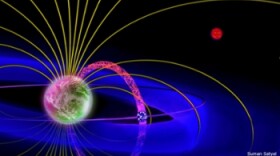Researchers from the University of Texas at Arlington are learning to predict the weather in space and measure its impact on Earth. But it's a tricky science because space weather activity is tied to the chaotic behavior of the sun.
Down in the office basement of the science building at the University of Texas at Arlington, graduate student Richard Bonde works on computer simulations to the quiet hum of servers. On a blue screen, there’s a circle – the earth – and there are colorful waves swaying up and down. They represent the sun’s blowing winds.
"The solar wind is coming really fast," Bonde says. "It’s moving at a million miles an hour and it slams into the earth’s magnetosphere. So it creates this shockwave. You can think of it as an airplane moving supersonic."
Those winds are caused by flares coming from the sun. Just like there are hurricanes here on Earth, solar storms rage outside the atmosphere.
"Space weather is when the environment in space changes and what drives those changes is the varying output from the sun," researcher Ramon Lopez says.
Lopez says most of the time, solar winds aren’t harmful but in the worst case scenario, they can do some real damage or at least mess up your directions.
"It’s just like if you look at a pencil and stick it into a glass of water," Lopez says. "The pencil looks bent so the pencil isn’t really exactly where you see it. So, that happens with GPS signals."

Lopez points to how space weather had an impact on a battlefield in Afghanistan.
"There was a communications difficulty and that contributed to the issue of that particular battle," says Lopez. "They went back through the records and said, ‘Hey, wait a second. We think the communications difficulty that we had was because of ionospheric disturbances.’"
'We need to always go back to the sun'
In April, Congress passed the Space Weather Research and Forecast Act to help track these disturbances in the atmosphere and what causes them.
"Basically, the automatic driver is the sun. We need to always go back to the sun," says UTA researcher Yue Deng.
Recently, Deng received a $7 million grant from the Department of Defense. She collaborates with researchers across the globe to study the sun’s chaotic behavior.
That’s because, at this point, space weather prediction is tricky. Especially when it comes to measuring the energy output of massive solar flares.
"That’s a big, big question for space weather forecast," Deng says. "We want to figure out, which one is coming, which one is not going to hit us and if it hit us, how bad is it?"
And while solar winds can be dangerous, they can also be beautiful when they're visible. In fact, they’re what causes the northern lights – the bright greens and purples of aurora borealis.
-UvSQ






